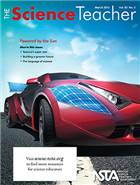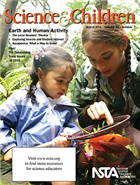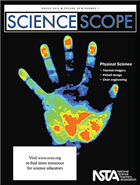Ideas and information from NSTA's March K-12 journals
By Mary Bigelow
Posted on 2016-03-13
This month, all three K-12 journals include What We Call Misconceptions May Be Necessary Stepping-Stones Toward Making Sense of the World (a must-read) and Outstanding Science Trade Books for Students K–12 (a must-share).
 The Science Teacher – Powered by the Sun
The Science Teacher – Powered by the Sun
Most of the lessons in TST include a detailed chart connecting the lesson to the NGSS.
- Science’s Super Star is not about celestial bodies—but the starlet sea anemone. The article describes how to culture these organisms in the classroom and the types of research students can conduct on their reproduction, growth and development, regeneration, and reactions to stimuli.
- Does It Mix? Introduces students to the concepts of hydrophilic and hydrophobic molecules.
- Building a Greener Future connects engineering and science in a project to design, construct, and test compost bins for a community garden.
- Science 2.0: Mastering Scientific Practices With Technology, Part 2 recommends technology tools that support the NGSS science and engineering practices of analyzing and interpreting data, using mathematics and computational thinking, and constructing explanations and designing solutions.
- Idea Bank: Using Earthquakes as “Teachable Moments” has a source of real-time information and data on earthquakes (the presentations are also available in Spanish). There are three entries to date for 2016. http://www.iris.edu/hq/retm/
- Powered by the Sun includes many photographs of an engineering challenge in which students designed, built, and tested solar-powered vehicles (with electric motors, solar cells, gears, and wheels).
For more on the content that provides a context for these projects and strategies see the SciLinks topics Cnidarians, Emulsions, Forces and Motion, Graphing Data, Math and Science, Measurements and Data, Solar Energy, Solubility, Solutions.
Continue for Science and Children and Science Scope.
 Science and Children- Earth and Human Activity
Science and Children- Earth and Human Activity
Spring is a perfect time for the featured lessons here on the connections between human behavior and the environment. Most of the lessons include a detailed chart connecting the lesson to the NGSS.
- The Lorax Readers’ Theater has an example of how to integrate literature and science, using a popular book.
- Capturing Insects and Student Interest builds on the interest students have in carnivorous plants through investigating, learning centers, and creating illustrated descriptions.
- Students explore sustainability in Aquaponics: What a Way to Grow! by designing and building aquaponic systems. The article has photos of the results of this 5E lesson.
- Understanding Human Impact is the focus of a lesson in which students learn about watersheds and the effect of human activity on the living things and the quality of the environment.
- Students take the role of marine biologist in the 5E lesson Crabby Interactions to study the impact of human activity on the blue crab and its environment.
- Teaching Through Trade Books: Humans and the Earth includes two lessons that trace objects to their origins (K-2) and study the impacts of natural disasters, specifically earthquakes (3-5). Trade books also are the basis for activities in Engineering Encounters: The Cat in the Hat Builds Satellites
- The Early Years: Composting With Children shows how young scientists can explore how materials decompose and how composting recycles these materials.
- Formative Assessment Probes: Is It Erosion or Weathering? explores differences between these two concepts that students may think are the same.
For more on the content that provides a context for these projects and strategies see the SciLinks topics Adaptations of Plants, Aquatic Plants and Animals, Arthropods, Composting, Decomposers, Deposition, Earthquakes, Earthquakes and Society, Erosion, Hydroponics, Natural Resources, Stream Deposition, Water Erosion, Watersheds, Weathering and Erosion, Wind Erosion.
 Science Scope – Physical Science
Science Scope – Physical Science
From new elements to engineering designs to technology enhancements, physical science and its applications are interesting to students (and teachers). Most of the lessons include a detailed chart connecting the lesson to the NGSS.
- Exposing Hidden Energy Transfer With Inexpensive Thermal Imaging Cameras uses this technology to help students understand and capture images of “missing” energy.
- If your students are new to problem-based learning, Chemical Connections: A Problem-Based Learning, STEM Experience provides a step-by-step example and advice that could apply to a variety of subject areas.
- Pinball Wizards illustrates a project in which students collaborated on designing and constructing a mechanical pinball machine,
- In another design project, Build Your Own Sunglasses, students apply what they’ve learned about light and UV radiation to design eye protection.
- Everyday Engineering: Sitting Around Designing Chairs presents a 5E lesson that challenges students do design a structure made of paper that will support their weights.
- Add some sparks to your unit on electricity with Tried and True: Measuring Static Electricity: A Classroom Investigation to Understand the Triboelectric Series.
- Take your students to a interdisciplinary level with Teacher’s Toolkit: A Framework for Cross-Disciplinary Engineering Projects with ideas for designing marble ramps and marshmallow towers.
For more on the content that provides a context for these projects and strategies see the SciLinks topics Forces and Motion, Heat Energy, Radiation from the Sun, Simple Machines, Static Electricity, Transfer of Energy, UV Index.
Disclaimer: The views expressed in this blog post are those of the author(s) and do not necessarily reflect the official position of the National Science Teaching Association (NSTA).


